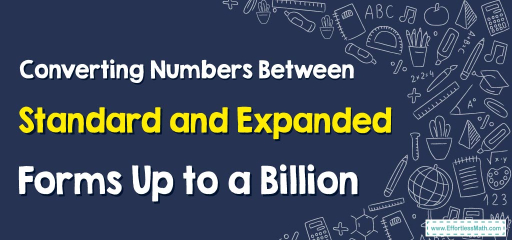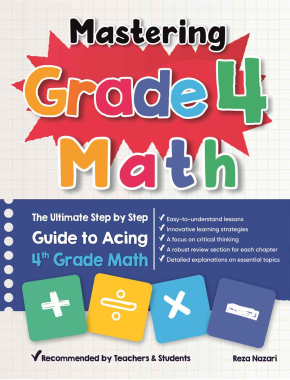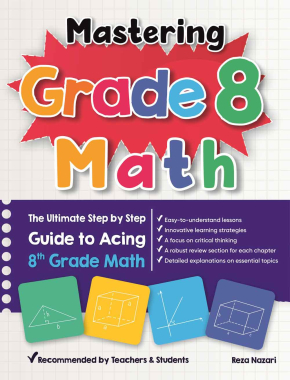Converting Numbers Between Standard and Expanded Forms Up to a Billion
Do you remember when you first learned to tie your shoelaces? It was a step-by-step process, right? Well, converting numbers between their standard and expanded forms can be viewed in much the same light. Let’s dive in, step by step!
[include_netrun_products_block from-products="product/6-south-carolina-sc-ready-grade-3-math-practice-tests/" product-list-class="bundle-products float-left" product-item-class="float-left" product-item-image-container-class="p-0 float-left" product-item-image-container-size="col-2" product-item-image-container-custom-style="" product-item-container-size="" product-item-add-to-cart-class="btn-accent btn-purchase-ajax" product-item-button-custom-url="{url}/?ajax-add-to-cart={id}" product-item-button-custom-url-if-not-salable="{productUrl} product-item-container-class="" product-item-element-order="image,title,purchase,price" product-item-title-size="" product-item-title-wrapper-size="col-10" product-item-title-tag="h3" product-item-title-class="mt-0" product-item-title-wrapper-class="float-left pr-0" product-item-price-size="" product-item-purchase-size="" product-item-purchase-wrapper-size="" product-item-price-wrapper-class="pr-0 float-left" product-item-price-wrapper-size="col-10" product-item-read-more-text="" product-item-add-to-cart-text="" product-item-add-to-cart-custom-attribute="title='Purchase this book with single click'" product-item-thumbnail-size="290-380" show-details="false" show-excerpt="false" paginate="false" lazy-load="true"]

Importance of Understanding Numbers
Numbers are everywhere! Whether you’re counting candies or noting down your scores in a game, numbers play an essential role. But did you know numbers have different forms?
Standard vs. Expanded Form
Imagine you’re building with Lego bricks. The entire structure is the “Standard Form”, and each individual Lego brick represents the “Expanded Form”. Intrigued? Keep reading!
The Absolute Best Book for 4th Grade Students
Understanding the Basics
What is the Standard Form?
In the standard form, numbers are written as we usually see them. For instance, 543 means five hundred and forty-three.
What is the Expanded Form?
Ever thought about breaking a number apart? In expanded form, we decompose numbers based on their place value. For example, 543 becomes 500 + 40 + 3.
Decomposing Numbers
Breaking Down the Digits
Think of a number as a puzzle. Each digit has its unique place and value. When we decompose numbers, we’re essentially seeing the parts that make up the whole puzzle.
A Perfect Book for Grade 4 Math Word Problems!
A Step-by-Step Guide to Converting Standard Form to Expanded Form
Step 1: Identify the Place Value
Begin with the leftmost number. What’s its value? If you’re working with 2,345, the 2 stands for two thousand!
Step 2: Multiply the Number by its Place Value
Take the identified number and multiply it by its place value. For the number 2 in 2,345, it becomes 2,000.
Step 3: Add Each Component Together
Proceed with each number in the sequence. For 2,345, it becomes 2,000 + 300 + 40 + 5.
Steps to Convert Expanded Form to Standard Form
Step 1: Understanding the Components
List down each part of the expanded form. For example, if you have 700 + 40 + 5, these are your components.
Step 2: Summing Up the Parts
Add them all up! 700 + 40 + 5 becomes 745.
Examples for Better Understanding
Converting 2,345 into Expanded Form
Following our steps: 2,345 is 2,000 + 300 + 40 + 5!
Converting 700 + 40 + 5 into Standard Form
Adding them together gives 745.
Practice Makes Perfect
Activities and Exercises
Just like practicing free throws in basketball, regularly converting numbers will make you a master in no time. Try converting different numbers on your own!
Benefits of Mastery
Building a Strong Math Foundation
Understanding number forms can be your stepping stone into the vast world of mathematics. A strong foundation now will help you in advanced topics later on.
Preparing for Advanced Math Topics
As you grow, math will introduce more complex concepts. Being proficient in basic concepts will make advanced ones seem like a breeze!
Final Words
Converting numbers is like a fun puzzle game. With practice and understanding, you’ll be effortlessly switching between standard and expanded forms. Ready for the next math adventure?
The Best Math Books for Elementary Students
Related to This Article
More math articles
- Full-Length 7th Grade IAR Math Practice Test-Answers and Explanations
- How to Graph Radical Functions
- 10 Most Common OAR Math Questions
- FREE 4th Grade NYSE Math Practice Test
- How to Solve Linear Inequalities in Two Variables?
- Top 5 Calculators for Geometry
- How to Factor Polynomials by Taking a Common Factor?
- Best Calculators for College Students
- Finding the Area Between Two Rectangles
- What Does the CBEST Test Qualify You For?


























What people say about "Converting Numbers Between Standard and Expanded Forms Up to a Billion - Effortless Math: We Help Students Learn to LOVE Mathematics"?
No one replied yet.